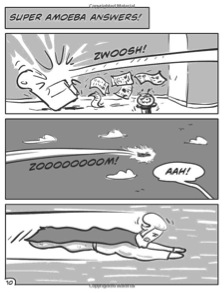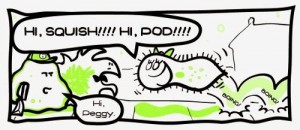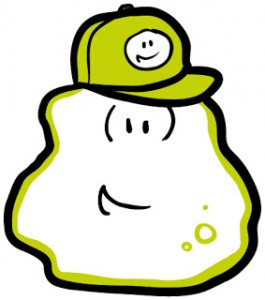Welcome to Using Graphic Novels in Education, an ongoing feature from CBLDF that is designed to allay confusion around the content of graphic novels and to help parents and teachers raise readers. In this column, we examine graphic novels, including those that have been targeted by censors, and provide teaching and discussion suggestions for the use of such books in classrooms.
“Earth. Our planet hosts a rich diversity of life…from lush rain forests to dry deserts.
But underneath this world lies another one. A microscopic world.
This is the home of the amoeba…”
— Jennifer and Matthew Holm, Squish (Random House), pp.7–9
So begins the adventures of the amoeba Squish and his friends, Pod and Peggy (an amoeba and a paramecium) in their microscopic world of Small Pond. In this column, we take a closer look at Squish, written by Jennifer and Matthew Holm, (Random House), providing teaching suggestions for the first four books in the series.
 Squish is a comic book-loving, Twinkie-eating, blubbery, super-swell amoeba “kid” who wrestles with good and evil in life around him and learns about life’s responsibilities. He faces all sorts of challenges with his friends Pod, a nerdy, mooching amoeba who’s always working on some lay-brained science scheme to help him tame his world, and Peggy, a clueless, huge-hearted, super-sweet, happy-go-lucky loving paramecium. In the first four books, they face challenges in school, summer camp, soccer games, and much more. While Squish is a beloved series in its own right, he was first brought to life and introduced in Babymouse #14: Mad Scientist (Babymouse is another award-winning series by Jennifer and Matthew Holm about a spunky young mouse).
Squish is a comic book-loving, Twinkie-eating, blubbery, super-swell amoeba “kid” who wrestles with good and evil in life around him and learns about life’s responsibilities. He faces all sorts of challenges with his friends Pod, a nerdy, mooching amoeba who’s always working on some lay-brained science scheme to help him tame his world, and Peggy, a clueless, huge-hearted, super-sweet, happy-go-lucky loving paramecium. In the first four books, they face challenges in school, summer camp, soccer games, and much more. While Squish is a beloved series in its own right, he was first brought to life and introduced in Babymouse #14: Mad Scientist (Babymouse is another award-winning series by Jennifer and Matthew Holm about a spunky young mouse).
We highlight Squish this month because it’s a wonderful series full of fun, humor, and real-life problems facing middle school “microorganism kids.” And while each volume is under 100 pages and geared for kids ages 7–12, they will be enjoyed by older readers as well with their compelling themes and sharp, sophisticated humor. These endearing pond-dwelling microorganisms deal with issues of friendship, bullies, overcoming fears, and learning that doing the right thing is one of life’s greatest challenges — and rewards — whether you’re a superhero like Super Amoeba, or a plain kid like Squish.
SERIES SUMMARY
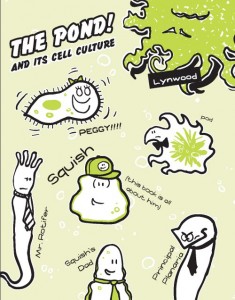 Squish’s volumes are packed with puns, alliteration, wordplay, humor, and hyperbole. In each book, Squish and his friends deal with real-life conflicts (handled with insight and compassion), issues of right and wrong, and the power and value of friendship. Furthermore, as Squish is an avid Super Amoeba comic book fan, each issue contains a parallel Super Amoeba comic book story, adding greater depth, humor, and insight. As an added bonus, at the end of each book there’s a cool “Fun Science Project with Pod” along with guidelines on how to draw one of the characters. Finally, the visually literate and the visually challenged can all have fun following the many faces on Squish’s baseball cap that change with his mood and given situation.
Squish’s volumes are packed with puns, alliteration, wordplay, humor, and hyperbole. In each book, Squish and his friends deal with real-life conflicts (handled with insight and compassion), issues of right and wrong, and the power and value of friendship. Furthermore, as Squish is an avid Super Amoeba comic book fan, each issue contains a parallel Super Amoeba comic book story, adding greater depth, humor, and insight. As an added bonus, at the end of each book there’s a cool “Fun Science Project with Pod” along with guidelines on how to draw one of the characters. Finally, the visually literate and the visually challenged can all have fun following the many faces on Squish’s baseball cap that change with his mood and given situation.
Squish #1: Super Amoeba introduces Squish, his supportive but seemingly useless dad, and Squish’s favorite comic book character, Super Amoeba. In this volume, we also meet Squish’s best friends Pod and Peggy, the principle of their school, Principle Planarian, and Peggy’s pet “Fluffy,” an ever-growing slime mold.
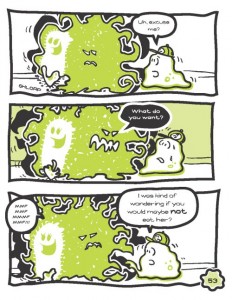 Pod is a science genius who mooches off of Squish — getting Squish to give him his lunch money for tacos (or his Twinkies) while Squish ends up with Pod’s vile lunch. Peggy is a sweet, supportive friend who unwittingly gets Squish into trouble.
Pod is a science genius who mooches off of Squish — getting Squish to give him his lunch money for tacos (or his Twinkies) while Squish ends up with Pod’s vile lunch. Peggy is a sweet, supportive friend who unwittingly gets Squish into trouble.
In this volume, Squish, Peggy, and Pod have to deal with the school bully Lynwood, who threatens to devour Peggy if Squish doesn’t let him cheat off of his science test. As Squish wrestles with this moral dilemma, Super Amoeba’s poster stares back at him as Super Amoeba says, “Have the courage to do what’s right!” Thanks to conviction and sheer luck, Lynwood is taken care of by the end of the book. The “Fun Science Project with Pod” is how to grow mold, and then readers can have some fun learning how to draw Squish.
Squish #2: Brave New Pond begins with Super Amoeba reading the Small Pond Gazette, which features the headline “A Hero is Born” — a nice bit of foreshadowing — and introduces a brand new school year for Squish. Squish is hoping for a fresh start and has made a list of what he wants to accomplish: no trading food with Pod, no detention, not letting Peggy embarrass him, getting picked for kickball, sitting with the cool kids at lunch, and simply being cool. While things unfortunately start off a bit rocky for Squish (he gives in to Pod’s mooching for starters), he does get to sit with the cool Algae Brothers.
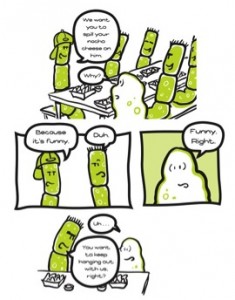 Super Amoeba is also starting the year with some “friends” in the Big City as they battle LEECHES, but things rarely turn out the way you think! This book is all about what makes a real hero, and how the pressure to be cool might make you do things that really aren’t cool at all. The “Fun Science Project with Pod” is how to make slime, and after that, readers learn how to draw the Algae Brothers.
Super Amoeba is also starting the year with some “friends” in the Big City as they battle LEECHES, but things rarely turn out the way you think! This book is all about what makes a real hero, and how the pressure to be cool might make you do things that really aren’t cool at all. The “Fun Science Project with Pod” is how to make slime, and after that, readers learn how to draw the Algae Brothers.
Squish #3: The Power of the Parasite takes place during the summer. Squish’s mom signs him up for swim lessons in the hope that he’ll overcome his fear of swimming, while Pod and Peggy go to ballet camp. At the pool, Squish meets a new friend, Basil, a hydra whose tentacles can paralyze living things, and Super Amoeba finds himself a sidekick named Parasite…or does he? Squish and Basil both find ways to not get into the water and still have fun, but in doing so things get out of hand.
In this issue, both Super Amoeba and Squish have to figure out how far they will let a friend go despite knowing that the friend is wrong. The “Fun Science Project with Pod” is all about how to “teach” an egg to swim, and after that, the volume shows readers how to draw Basil.
Squish #4: Captain Disaster is all about what being a leader means. In this particular issue, Squish must learn what it means to be the captain of his soccer team (trying to observe his players and help them play to their strengths), and how to balance the thrill of winning with the need to keep the game fun. Meanwhile, Super Amoeba has to find more effective ways of fighting Worms and tries the enlist the help of an old friend while teaching his fans that “Small Pond needs to remember that every hero has a part to play.” The “Fun Science Project with Pod” is an experiment on air pressure, and after that, the authors show readers how to draw Pod.
Throughout the Squish series, Jennifer and Matthew Holm relate:
- What it takes to be a hero;
- How to juggle your dreams with the realities facing you;
- How to overcome and face your fears;
- The importance of friendship and of standing up for your friends;
- The struggle of trying to fit into social groups;
- The struggle of knowing and doing what is right;
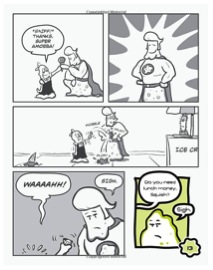 Fun Science Facts Packed in Four Volumes
Fun Science Facts Packed in Four Volumes
While these books are pure fiction and tons of fun, there is some science packed into them. Part of the fun is learning to distinguish the fact from the fiction, which I discuss in greater detail below. Here are a few things students will learn about the intriguing world of microscopic organisms.
In Squish #1: Super Amoeba readers learn:
- That amoebas belong to Kingdom Protista, are single-celled organisms, microscopic, reproduce by binary fission (basically, splitting), come in all shapes and sizes, and move using pseudopods;
- That planaria are flatworms;
- That photosynthesis is the process by which plants and many protists capture sunlight to make sugar; and
- That E. coli and other bacteria, slime mold, and algae are also microorganisms found in a pond.
In Squish #2: Brave New Pond readers learn:
- That paramecia don’t like negative stimuli;
- That planaria can regenerate when cut in half;
- That protozoans are single-celled microscopic organisms that live in water; and
- That algae live in ponds and are “the coolest microorganisms in the pond” because they produce oxygen.
In Squish #3: The Power of the Parasite readers learn:
- That hydras are also microorganisms found in ponds; and
- That hydra have tentacles that can paralyze living things and can grow/regenerate body parts.
In Squish #4: Captain Disaster readers learn:
- That a cyclops is a crustacean (related to shrimp and lobster), and that they have one eye; and
- That instead of hands and feet, paramecia use cilia to move.
TEACHING/DISCUSSION SUGGESTIONS:
Plot, Themes, and Values
- Chart and discuss the different themes relayed (i.e. friendship, identity) in each of the books.
- Discuss what Squish does to be one of the cool kids, and evaluate each strategy’s effectiveness. Create a class definition of what is “cool” and discuss how far your students might go to be cool and fit in. You may also want to discuss how far they might go to win.
- Discuss different types of friendships one might have with others. Detail what it means to be a good friend. Discuss the challenges we face in determining and maintaining friendships and why this is so important.
- Squish # 2: Brave New World opens with Squish wanting to begin the school year on a fresh start. Discuss why fresh starts can be so important, and what they often entail. Have students think about their own fresh starts: what they might look like and why.
- In Squish #3: The Power of the Parasite, Squish has to face his fear of swimming. The counselor/life guard tells Squish and Basil that “you have to face your fear, like it’s a wave coming at you.” Discuss this use of simile and how effective it is. You may also want to discuss what terror and fear feels like, what it looks like (in others and/or in yourselves), and what types of words can be used to describe it. Discuss ways and means of overcoming fears.
- Research and discuss the microorganisms found in ponds.
- The insides of Pod, Peggy, and Squish are green (indicating nuclei and other cellular structures). Have students research what amoebas, paramecia, hydra, algae, and planaria look like (see links below for resources). You may want to divide the class into groups to research and present one of the organisms to the class.
- Evaluate and analyze science facts from science fictions. Create a four-columned table in which you compare and contrast the information presented in the books. Label the first column “Page Number,” the second column “Science Fact,” the third column “Science Fiction,” and the fourth column “Something to Research Further.” As students go through the book, have them enter its content under the appropriate columns. Discuss and evaluate what they found.
- Assign a creative writing project in which students take an item in the “Something to Research Further” column from the table above and create their own stories around it. Discuss their use and balancing of fact and fiction in their stories. You may also want to brainstorm and have them create their own sequels integrating science facts and fictions.
- Discuss the following science topics from Squish #1: Super Amoeba:
- Pod talks about global warming and his goal to stop it. Discuss how global warming would affect the organisms in Small Pond.
- Discuss photosynthesis. Why is photosynthesis so vital to life in a pond?
- Discuss the following science topics from Squish #2: Brave New Pond:
- Planaria and hydra can regenerate (regrow) body parts. Why is that so important?
- What role does slime play in ponds?
- Discuss the following science topics from Squish #3: The Power of the Parasite:
- The introduction of hydra in this book, particularly their ability to paralyze prey. Research and discuss how the other microorganisms consume and capture prey.
- While very fictionalized, the authors discuss how Pod is taking ballet because he believes “the subtle physics of ballet is going to help me understand how to create black holes.” Discuss the facts and fictions of this statement.
- Discuss the following science topics from Squish #4: Captain Disaster
- The introduction of a cyclops — a crustacean related to shrimp and lobster. Have students research these creatures — their form, their mechanisms of defense, their food, etc. Consider asking students to discuss the name and its reference to Greek myth.
- In this book we also read a bit more on a paramecium’s use of cilia for locomotion. You may want to divide the class into groups to discuss how other microorganisms move and eat.
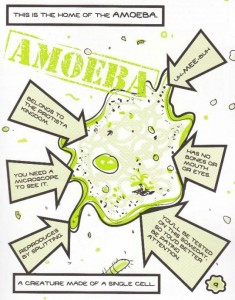 Critical Reading and Making Inferences
Critical Reading and Making Inferences
- Compare and contrast the challenges Super Amoeba faces in each book to Squish’s challenges. How are they similar and different? Why do you think the Holms’ use the Super Amoeba character in their stories?
- The titles for each of these books are wonderfully succinct and creative while relaying a lot about the themes of the books and alluding to other classic reads. Discuss the authors’ choice of titles.
- Search and discuss the advice and inferences that Dad, Super Amoeba and the narrator relay. For example:
- Squish #1, p. 48: The narrator notes that Peggy is “super sweet, super clueless, and not going to live long.” Using the text and the images, discuss why the narrator says this.
- Squish #2: Dad notes: “fresh starts are good, but you shouldn’t change who you are just to impress people.” Discuss what dad is trying to tell Squish.
- Squish #3: Super Amoeba tells Parasite their partnership isn’t working out because Parasite is “in it for the power.” Discuss what this really means and why this doesn’t work for Super Amoeba. You may also want to discuss Parasite’s response: “What’s wrong with a little power? We’re superheores! We deserve it!” Discuss whether/when anyone “deserves” power.
- Squish #4: The coach tells Squish that, “your job as captain is to keep the ball moving and give everyone a chance to play, okay? Steer the ship.” Discuss what the coach means by “steer the ship.” Why is this presented in bold letters?
- Squish #4, p. 80: Discuss Super Amoeba’s statement, “Small Pond needs to remember that every hero has a part to play.”
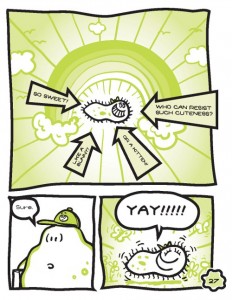 Language, Literature, and Language Usage
Language, Literature, and Language Usage
- The authors employ a lot of different voices to relay their stories. The story is told through Squish and supporting characters, through Super Amoeba, and through a narrator. Compare and contrast how these voices are similar and different.
- Search for and discuss the use of inference, simile, and metaphor in each of these books.
- While there are only short bursts of text in these volumes, discuss the authors’ word choices and frequent use of literary devices such as alliteration, puns, and hyperbole. Chart the frequency of their use, including their examples and word choices. Discuss why each of these devices is used and how effective they are in telling the story.
- Evaluate the Holms’ use of language. You might discuss:
- Squish #1, p. 41: The narrator notes that, “amoebas come in all shapes and sizes. Just like snowflakes! (Some are pure evil)”
- Squish #2, p. 20: Peggy is “so sweet she could melt.” Discuss this use of hyperbole, what it really means, and how effective it is at expressing a point. How else might the authors have expressed this?
- Squish #2, p. 74: There is a wonderful play on words with “leeches, those blood suckers…this is a red alert” Discuss how this play with words effects the reading experience.
- Squish #3, p. 21: We see four panels. The second is labeled “Still Later” and the third is labeled “And Laterer. I don’t know if “laterer” is a word, but it should be.” Discuss why the authors make this word up now. What kind of image are they trying to create and why here?
- Squish #4: Squish and his teammates, The Water Fleas, play against other teams from the pond. Discuss their names (The Sharks and The Razor Fish). Discuss the power of names. Should The Water Fleas change their name? Might it make a difference? Why/why not?
Modes of Storytelling and Visual Literacy
In graphic novels, images are used to relay messages with and without accompanying text, adding additional dimension to the story. Compare and contrast the authors’ use of verbal versus visual imagery. Discuss with students how images can be used to relay complex messages. For example:
- As noted above, there are various voices telling the Squish story. Discuss how the authors use art and text to help distinguish between the different voices and stories.
- Evaluate and discuss how the authors relay scientific information while keeping the story light, interesting and funny.
- Squish’s hat has awesome powers — the face on the front changes with Squish’s moods and obstacles. Discuss how this helps relay information and cues for the reader. Is it helpful or distracting? Explain.
- Discuss the power of an image and how much it can relay and foreshadow. For example, in Squish #3, p. 12, evaluate and discuss how Parasite is portrayed in the top image versus how he is ortrayed in the bottom one. Are the authors trying to tell us something? If so, what?
Suggested Prose and Graphic Novel Pairings
For greater discussion of literary style, and non-fiction texts you may want to read the following suggestions with Squish:
- Babymouse by Jennifer and Matthew Holm: A series about a spunky young mouse who, like Squish, deals with real-life issues such as friendship, following one’s dreams, dealing with defeat and challenges in and out of school, and about embracing one’s strengths and weaknesses.
- Protozoans, Algae & Other Protists by Steve Parker: A great nonfiction book for kids with fascinating images and details.
- Astronaut Academy by Dave Roman: A graphic novel series about kids who go to school in space. When pairing this with Squish, you may compare and contrast the author’s incorporation of science facts and fictions. You may also want to compare/contrast their use of image and text, character development, and themes.
- Diary of a Wimpy Kid by Jeff Kinney: A series about life for Greg Heffley and his friends in middle school, as told by Greg and his journal entries. You may want to compare/contrast the story telling in this illustrated prose book with its movie and/or with the graphic novels suggested above.
- Pippi Longstocking by Astrid Lindgren: About Timmy, his sister Annika, and the adventures they take with Pippi. Their stories feel like exaggerated tales, much like Squish’s, and can be excellent pairings regarding storytelling and character development.
- Charlottes Web by E.B. White: A classic about a talking pig who befriends a literate spider. Here too, there are some animal facts and fictions to compare and contrast.
Common Core State Standards (CCSS)
As this book is appropriate for grades 3–7, I will be using the Common Core Anchor Standards to relay how the book and suggested discussions above can be used to meet CCSS for Reading, Writing, and Speaking and Listening:
- Key ideas and details: Reading closely to determine what the texts says explicitly and making logical inferences from it; citing specific textual evidence when writing or speaking to support conclusions drawn from the text; determining central ideas or themes and analyzing their development; summarizing the key supporting details and ideas; analyzing how and why individuals, events, or ideas develop and interact over the course of the text.
- Craft and structure: Interpreting words and phrases as they are used in a text, including determining technical, connotative, and figurative meanings, and analyzing how specific word choices shape meaning or tone; analyzing the structure of texts, including how specific sentences, paragraphs and larger portions of the text relate to each other and the whole; assessing how point of view or purpose shapes the content and style of a text.
- Integration of knowledge and ideas: Integrating and evaluating content presented in diverse media and formats, including visually and quantitatively, as well as in words; delineating and evaluating the argument and specific claims in a text, including the validity of the reasoning as well as the relevance and sufficiency of the evidence; analyzing how tow or more texts address similar themes or topics in order to build knowledge or to compare the approaches the author takes.
- Range of reading and level of text complexity: Reading and comprehending complex literary and informational texts independently and proficiently
Next Generation Science Standard and Disciplinary Core Ideas
LS2.D: Social Interactions and Group Behavior: Being part of a group helps animals obtain food, defend themselves, and cope with changes. Groups may serve different functions and vary dramatically in size (3-LS2-1).
LS2.C: Ecosystem Dynamics, Functioning, and Resilience: When the environment changes in ways that affect a place’s physical characteristics, temperature, or availability of resources, some organisms survive and reproduce, others move to new locations, yet others move into the transformed environment, and some die (secondary to 3-LS4-4)
LS4.C Adaptation: For any particular environment, some kids of organisms survive well, some survive less well, and some cannot survive at all (3-LS4-3).
LS1.A: Structure and Function: Plants and animals have both internal and external structures that serve various functions in growth, survival, behavior and preproduction (4-LS1-1); All living things are made up of cells, which is the smallest unit that can be said to be alive. An organism may consist of one single cell or different numbers and types of cells (MS-LS1-1); Within cells, special structures are responsible for particular functions, and the cell membrane forms the boundary that controls what enters and leaves the cell (MS-LS1-2);
LS1.D: Information Processing: Different sense receptors are specialized for particular kinds of information, which may be then processed by the animal’s brain. Animals are able to use their perceptions and memories to guide their actions. (4-LS1-2)
LS1.C: Organization for Matter and Energy Flow in Organisms: Plants, algae and many microorganisms use the energy from light to make sugars (food) from carbon dioxide from the atmosphere and water through the process of photosynthesis, which also releases oxygen. These sugars can be used immediately or stored for growth or later use (MS-LS1-6)
ADDITIONAL RESOURCES:
- Guide to identification of fresh water microorganisms: A wonderful chart with images, characteristics, and taxonomies for freshwater organisms including algae, protozoa, plankton, and arthropods. Excellent resource to use when reading Squish.
- Growing with Science blog post “Exploring the Protists with Squish: Super Amoeba” with a slew of wonderful images and facts about amoebozoans, slime molds, ciliates (paramecia), and planaria; videos highlighting these microscopic organisms; and related science activities (“grow bread mold,” “hay infusion,” and “purchase protozoan cultures,”
- http://www.microscope-microscope.org/applications/pond-critters/pond-critters.htm: Pond Water Critters and what they look like with a microscope, with additional links.
- Science games for kids: microorganisms: Information on microorganisms and games to see them at work under a microscope.
- Microorganisms for Kids (from NeoK12): Explains what microorganisms are, how they are classified, where they are found, and has pictures and suggestions for school presentations; has videos and lesson plans and lots of games.
- http://science.lotsoflessons.com/pondlife.html: Lesson plans for teachers on pond life, pond scum, biodiversity of ponds, along with games for kids.
- Kid’s Biology: Amoebas: Animal facts and links all about amoebas
- Britannica Kids: Hydra: Excellent information and links.
- http://animal.discovery.com/worms/planarian-info.htm: All about planaria.
Meryl Jaffe, PhD teaches visual literacy and critical reading at Johns Hopkins University Center for Talented Youth OnLine Division and is the author of Raising a Reader! and Using Content-Area Graphic Texts for Learning. She used to encourage the “classics” to the exclusion comics, but with her kids’ intervention, Meryl has become an avid graphic novel fan. She now incorporates them in her work, believing that the educational process must reflect the imagination and intellectual flexibility it hopes to nurture. In this monthly feature, Meryl and CBLDF hope to empower educators and encourage an ongoing dialogue promoting kids’ right to read while utilizing the rich educational opportunities graphic novels have to offer. Please continue the dialogue with your own comments, teaching, reading, or discussion ideas at meryl.jaffe@cbldf.org and please visit Dr. Jaffe at http://www.departingthe text.blogspot.com.
The fifth volume of Squish, Game On, is available in the CBLDF Rewards Zone. Please help support CBLDF’s important First Amendment work by picking up a copy, making a donation, or becoming a member of CBLDF!
All images (c) Jennifer and Matthew Holm

